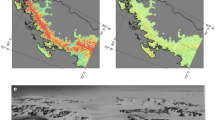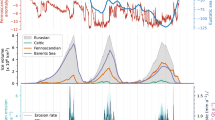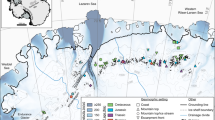Abstract
Landscapes modified by glacial erosion show a distinct distribution of surface area with elevation1,2,3 (hypsometry). In particular, the height of these regions is influenced by climatic gradients controlling the altitude where glacial and periglacial processes are the most active, and as a result, surface area is focused just below the snowline altitude1,2,3,4,5,6,7,8,9. Yet the effect of this distinct glacial hypsometric signature on glacial extent and therefore on continued glacial erosion has not previously been examined. Here we show how this topographic configuration influences the climatic sensitivity of Alpine glaciers, and how the development of a glacial hypsometric distribution influences the intensity of glaciations on timescales of more than a few glacial cycles. We find that the relationship between variations in climate and the resulting variation in areal extent of glaciation changes drastically with the degree of glacial modification in the landscape. First, in landscapes with novel glaciations, a nearly linear relationship between climate and glacial area exists. Second, in previously glaciated landscapes with extensive area at a similar elevation, highly nonlinear and rapid glacial expansions occur with minimal climate forcing, once the snowline reaches the hypsometric maximum. Our results also show that erosion associated with glaciations before the mid-Pleistocene transition at around 950,000 years ago probably preconditioned the landscape—producing glacial landforms and hypsometric maxima—such that ongoing cooling led to a significant change in glacial extent and erosion, resulting in more extensive glaciations and valley deepening in the late Pleistocene epoch. We thus provide a mechanism that explains previous observations from exposure dating10 and low-temperature thermochronology11 in the European Alps, and suggest that there is a strong topographic control on the most recent Quaternary period glaciations.
This is a preview of subscription content, access via your institution
Access options
Subscribe to this journal
Receive 51 print issues and online access
$199.00 per year
only $3.90 per issue
Buy this article
- Purchase on Springer Link
- Instant access to full article PDF
Prices may be subject to local taxes which are calculated during checkout



Similar content being viewed by others
References
Brocklehurst, S. H. & Whipple, K. X. Hypsometry of glaciated landscapes. Earth Surf. Process. Landf. 29, 907–926 (2004)
Egholm, D. L., Nielsen, S. B., Pedersen, V. K. & Lesemann, J. E. Glacial effects limiting mountain height. Nature 460, 884–887 (2009)
Pedersen, V. K., Egholm, D. L. & Nielsen, S. B. Alpine glacial topography and the rate of rock column uplift: a global perspective. Geomorphology 122, 129–139 (2010)
Brozović, N., Burbank, D. & Meigs, A. Climatic limits on landscape development in the northwestern Himalaya. Science 276, 571–574 (1997)
Mitchell, S. G. & Montgomery, D. R. Influence of a glacial buzzsaw on the height and morphology of the Cascade Range in central Washington State, USA. Quat. Res. 65, 96–107 (2006)
Montgomery, D. R., Balco, G. & Willett, S. D. Climate, tectonics, and the morphology of the Andes. Geology 29, 579–582 (2001)
Whipple, K. X., Kirby, E. & Brocklehurst, S. H. Geomorphic limits to climate-induced increases in topographic relief. Nature 401, 39–43 (1999)
Hales, T. C. & Roering, J. J. A frost “buzzsaw” mechanism for erosion of the eastern Southern Alps, New Zealand. Geomorphology 107, 241–253 (2009)
Delunel, R., van der Beek, P. A., Carcaillet, J., Bourlès, D. L. & Valla, P. G. Frost-cracking control on catchment denudation rates: insights from in situ produced 10Be concentrations in stream sediments (Ecrins–Pelvoux massif, French Western Alps). Earth Planet. Sci. Lett. 293, 72–83 (2010)
Haeuselmann, P., Granger, D. E., Jeannin, P.-Y. & Lauritzen, S. E. Abrupt glacial valley incision at 0.8 Ma dated from cave deposits in Switzerland. Geology 35, 143–164 (2007)
Valla, P., Shuster, D. L. & van der Beek, P. A. Significant increase in relief of the European Alps during mid-Pleistocene glaciations. Nature Geosci. 4, 688–692 (2011)
Kerr, A. Topography, climate and ice masses: a review. Terra Nova 5, 332–342 (1993)
Oerlemans, J. Numerical experiments on large-scale glacial erosion. Z. Gletsch. Glazialgeol. 20, 107–126 (1984)
Foster, D., Brocklehurst, S. H. & Gawthorpe, R. L. Glacial-topographic interactions in the Teton Range, Wyoming. J. Geophys. Res. 115, F01007 (2010)
Brocklehurst, S. H. & Whipple, K. X. Glacial erosion and relief production in the eastern Sierra Nevada, California. Geomorphology 42, 1–24 (2002)
Braun, J., Zwartz, D. & Tomkin, J. A new surface-processes model combining glacial and fluvial erosion. Ann. Glaciol. 28, 282–290 (1999)
Herman, F., Beaud, F., Champagnac, J.-D., Lemieux, J.-M. & Sternai, P. Glacial hydrology and erosion patterns: a mechanism for carving glacial valleys. Earth Planet. Sci. Lett. 310, 498–508 (2011)
MacGregor, K., Anderson, R., Anderson, S. & Waddington, E. Numerical simulations of glacial longitudinal profile evolution. Geology 28, 1031–1034 (2000)
Tomkin, J. Feedbacks and the oscillation of ice masses. J. Geophys. Res. 108 (B10). 2488 (2003)
Yanites, B. J. & Ehlers, T. A. Global climate and tectonic controls on the denudation of glaciated mountains. Earth Planet. Sci. Lett.. 325/326, 63–75 (2012)
Egholm, D. L., Knudsen, M. F., Clark, C. D. & Lesemann, J. E. Modeling the flow of glaciers in steep terrains: the integrated Second-Order Shallow Ice Approximation (iSOSIA). J. Geophys. Res. 116, F02012 (2011)
Egholm, D. L., Pedersen, V. K., Knudsen, M. F. & Larsen, N. K. On the importance of higher order ice dynamics for glacial landscape evolution. Geomorphology 141/. 142, 67–80 (2012)
Egholm, D. L., Pedersen, V. K., Knudsen, M. F. & Larsen, N. K. Coupling the flow of ice, water, and sediment in a glacial landscape evolution model. Geomorphology 141/. 142, 47–66 (2012)
Lisiecki, L. E. & Raymo, M. E. A. Pliocene-Pleistocene stack of 57 globally distributed benthic δ18O records. Paleoceanography 20, PA1003 (2005)
Alberti, A. P., Díaz, M. V. & Chao, R. B. in Quaternary Glaciations—Extent and Chronology. Part I. Europe (eds Ehlers, J. & Gibbard, P. L.). 389–394 (2004)
Weber, W. M. Correlation of Pleistocene glaciation in the Bitterroot Range, Montana, with fluctuations of Glacial Lake Missoula, Montana. Bur. Mines Geol. Mem. 42, 1–44 (1972)
Porter, S. C. Some geological implications of average Quaternary glacial conditions. Quat. Res. 32, 245–261 (1989)
Kaplan, M. R., Hein, A. S., Hubbard, A. & Lax, S. M. Can glacial erosion limit the extent of glaciation? Geomorphology 103, 172–179 (2009)
Steer, P., Huismans, R. S., Valla, P. G., Gac, S. & Herman, F. Bimodal Plio-Quaternary glacial erosion and low-relief surfaces in Scandinavia. Nature Geosci. 5, 635–639 (2012)
Farr, T. G. et al. The shuttle radar topography mission. Rev. Geophys. 45, RG2004 (2007)
Acknowledgements
V.K.P. thanks the Danish Council for Independent Research and Inge Lehmanns Fund for funding this research. D.L.E. acknowledges funding from the Danish Council for Independent Research under the Sapere Aude Programme. We thank S. Brocklehurst and P. van der Beek for reviews that improved the manuscript considerably.
Author information
Authors and Affiliations
Contributions
V.K.P. and D.L.E. performed the global topographic analysis. D.L.E. developed the numerical modelling scheme used. V.K.P. performed the modelling. Both authors contributed equally to the design of the study and writing of the paper.
Corresponding author
Ethics declarations
Competing interests
The authors declare no competing financial interests.
Supplementary information
Supplementary Information
This file contains Supplementary Methods, a Supplementary Discussion, Supplementary Tables 1-2 and Supplementary Figures 1-29, which contain additional information on methodology and discuss some additional aspects of the results presented in the main text. (PDF 30796 kb)
Glaciating the fluvial Sierra Nevada, Spain
This video shows the landscape from the fluvial Sierra Nevada in Spain. The camera flies over the computer rendered landscape. By varying the snowline altitude, it is illustrated how the extent of glaciation relates to climate a simpler way than for the Bitterroot Range (Video 2). This is because the Sierra Nevada topography is without a hypsometric maximum. The landscape shown is a computer rendered version of the model used in Figure 1. (MOV 25442 kb)
Glaciating the glacial Bitterroot Range, USA
This video shows the landscape from the glacially eroded Bitterroot Range. It presents the glacial topography, and illustrates how glaciation is nonlinearly related to snowline altitude, owing to the well-developed hypsometric maximum found in the area. The landscape shown is a computer rendered version of the model used in Figure 1. (MOV 25126 kb)
Simulated Quaternary changes in ice volume following glacial erosion
This video shows the modeled landscape and the ice extent as the altitude of the snowline varies. First a series of 40 kyr glacial cycles are shown, and then the video jumps to the transition to colder 100 kyr cycles. The video shows how a negative feedback from erosion decreases the extent of glaciation under constant magnitude glacial cycles, and how this feedback is broken when lowering of the snowline reincorporates the previously eroded topography in the accumulation zone of glaciers. (MOV 28599 kb)
Glacial modification of a synthetic fluvial landscape
This video shows the synthetic landscape used for simulating transient effects of landscape development on the extent of glaciation. The camera first flies over the initial fluvial landscape, and then the final glacially eroded landscape. The video thus illustrates the total transformation from fluvial to glacial topography. The landscapes shown are computer rendered versions of the model used in Figure 2 and 3. (MOV 23454 kb)
Rights and permissions
About this article
Cite this article
Pedersen, V., Egholm, D. Glaciations in response to climate variations preconditioned by evolving topography. Nature 493, 206–210 (2013). https://doi.org/10.1038/nature11786
Received:
Accepted:
Published:
Issue Date:
DOI: https://doi.org/10.1038/nature11786
This article is cited by
-
Antarctic Peninsula glaciation patterns set by landscape evolution and dynamic topography
Nature Geoscience (2024)
-
Feedbacks between sea-floor spreading, trade winds and precipitation in the Southern Red Sea
Nature Communications (2022)
-
A report on tectonically sculptured unique glacier landform: a case study from the Tethys Kumaun Himalaya, India
Geosciences Journal (2022)
-
Research on geological and surfacial processes and major disaster effects in the Yellow River Basin
Science China Earth Sciences (2022)
-
Steady erosion rates in the Himalayas through late Cenozoic climatic changes
Nature Geoscience (2020)
Comments
By submitting a comment you agree to abide by our Terms and Community Guidelines. If you find something abusive or that does not comply with our terms or guidelines please flag it as inappropriate.



